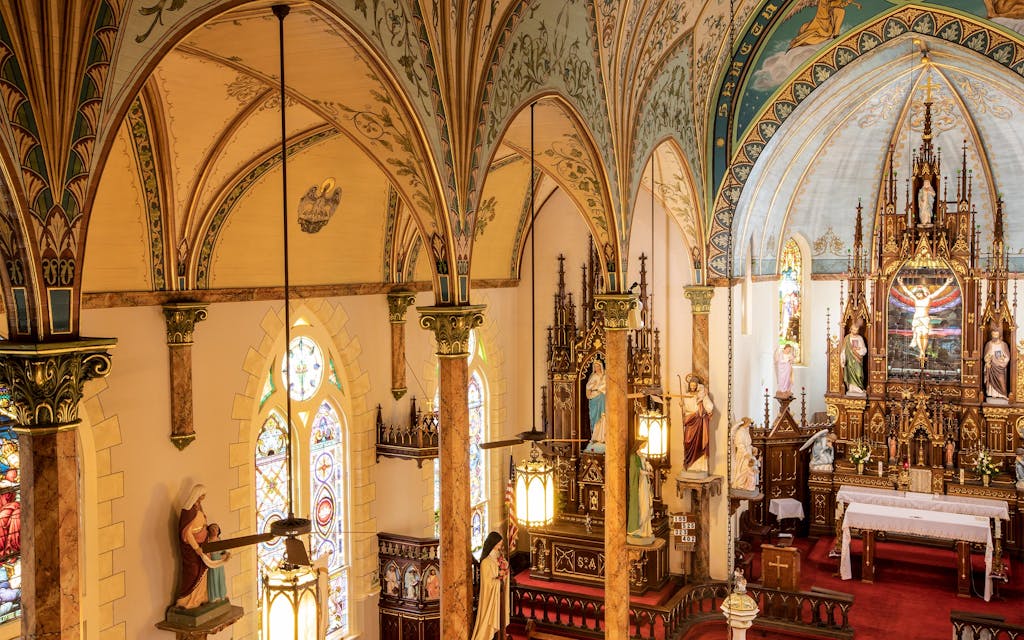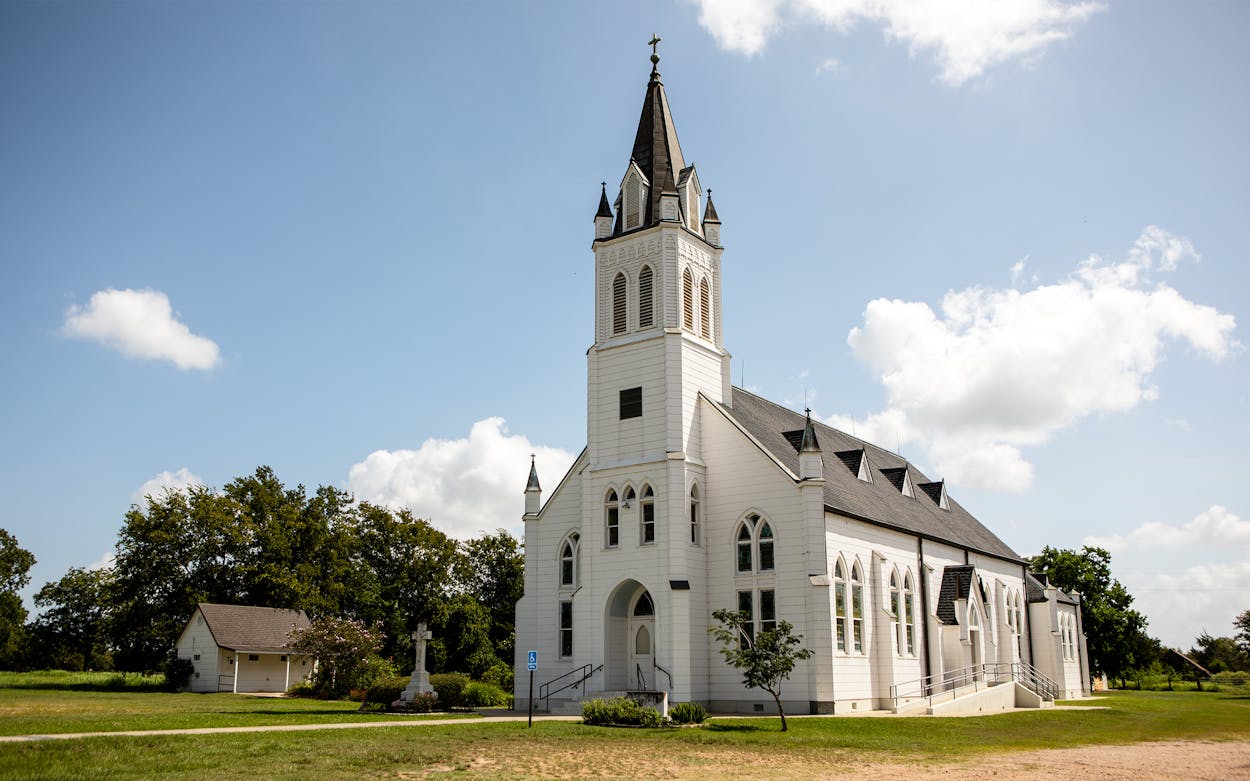On June 21, 1983, fifteen Texas churches built between 1859 and 1930 were listed together in the National Register of Historic Places (NRHP) under the designation “Churches in Texas with Decorative Interior Painting.” Today they’re known colloquially and collectively as the “painted churches” because their ceilings, walls, and other interior features were treated as blank canvases on which decorative painters added cultural, religious, and purely aesthetic ornamentation. The works found within these churches are rare artistic expressions of faith and heritage.
The majority of the painted churches are Catholic and stand clustered in south Central Texas between Houston and San Antonio, especially where Bohemians, Moravians, Germans, and other Europeans began settling in large numbers during the 1850s. Others are located further away—as far north as Amarillo. Within each, there may be any combination of freehand painting, graining, marbling, and stenciling, all applied directly onto interior surfaces. These techniques accentuate existing architecture as well as give a simple country chapel the appearance of an old-world cathedral.
Buie Harwood, who researched her book Decorating Texas: Decorative Painting in the Lone Star State from the 1850s to the 1950s while teaching for the University of Texas at Austin’s interior design program, was instrumental in locating many of these churches and more than three hundred other surviving structures—homes, banks, stores—decorated to varying degrees with this once common form of interior design for the middle and upper classes. Harwood points out that inaccurate, incomplete, or nonexistent documentation has meant that many artists’ names have been forgotten. “Some information was readily available via archives, articles, oral histories, on-site research work, and family memorabilia,” she says. “In other cases, no one knew anything, so it took a lot of extra work . . . to put all the parts together and identify some of the artists.” The painters were professionals and amateurs, working in different parts of the state and sometimes in different centuries.
These artists and their beautifying techniques fell out of fashion as Texas kept modernizing after World War II; some churches even repainted their interiors to cover the old art (a practice not unknown even today).
After two years of researching the painted churches with photographer Kirk Weddle for our upcoming book, Inside the Painted Churches of Texas, from Texas A&M University Press, I think there may be up to 35 surviving churches with similarly painted elements. Most of these churches don’t look like anything out of the ordinary from the outside; many are in out-of-the-way towns where you’d really have to look to find them. All are worth visiting, but the five below are a great place to start. Like most of the painted churches, these hidden gems hold regular services and are open to the public.
St. John the Baptist Catholic Church (Ammannsville)
On October 2, 1917, fire consumed St. John the Baptist church in Ammannsville, halfway between Houston and San Antonio. Two years later, John F. Bujnoch built the current church as an example of early twentieth-century Carpenter Gothic, improvising with wood what had been done with stone in Europe.
Inside, with no support columns, the nave feels roomy, while dusty-rose walls convey warmth. The floor-to-ceiling decorative painting reflects Ammannsville’s Czech heritage, although many Germans also settled in this town.
Various stenciled patterns and freehand painting along the upper and lower walls include charming floral patterns and draped garlands. Repeating motifs of purely decorative work, such as simple interwoven circles and more elaborate, multicolored geometric designs, also appear throughout.
In 1983, when the church was listed in the NRHP, the name of its interior artist had been forgotten. Harwood eventually uncovered the painter’s identity: San Antonio fresco artist Fred Donecker.

Nativity of Mary, Blessed Virgin Catholic Church (High Hill)
In unincorporated High Hill, one hundred miles west of Houston, the 1906 redbrick Catholic church known locally as St. Mary’s was built for a community of Germans and Austrian-Moravians of German descent, who had been settling within the Fayette prairie since at least the 1850s.
San Antonio painters Ferdinand Stockert and Herman Kern were commissioned to beautify the church’s interior, and what they accomplished in just a few months during 1912 remains a remarkable artistic achievement. With cleverness and acumen, they re-created the grandeur of a European cathedral within a much more modest space.
Eight ocher-colored wooden columns appear to be made of marble, a trompe l’oeil effect produced with multiple stages of painting. Colorful flowering vines cluster around the tops of these columns and throughout the nave. The Gothic rib-vault ceilings were painted so skillfully that they provide the illusion of crossing wooden beams.
Immaculate Conception of the Blessed Virgin Mary Catholic Church (Panna Maria)
Immaculate Conception was completed in 1878 in Panna Maria, the country’s oldest permanent Polish settlement. During a major 1937 renovation, the church ceiling was completely covered with large tiles. In 2000 the tiles were removed, exposing a hand-painted ceiling that had not been viewed for decades.
The artwork includes eight traditional Christian symbols, such as the Lamb of God atop the Book of Revelation, added to the church at some unknown time by a still-unknown artist. Father Antoni Polaniak, a painter in addition to a priest, traveled from Poland to southeast Texas to restore the newly rediscovered work. In addition to painting rings of white fluffy clouds around each image, Polaniak contributed his own works, including the image of a ship that commemorates the first Polish colonists crossing the ocean, bound for Texas.
First United Methodist Church (Paris)
Nearing its century mark, the steel-and-limestone First United Methodist was completed in April 1924, about a hundred miles northeast of Dallas in downtown Paris. Its three-story domed architecture has often been compared to certain Renaissance-era villas built in northern Italy.
Inside the 1,650-seat sanctuary, the natural focal point is the octagonal clerestory overhead. Elmer Van Slyke, one of the architects, designed the elaborate stained glass inset and its Easter lily motif.
A burning lamp, a Bible, and other traditional Christian symbols appear on the clerestory’s lower segments, modestly rendered when compared to the enormity of the auditorium. The icons are pictured within painted crescents of wrapped garlands, which were formerly bordered by decorative rinceaux of twisting leafy stems. (During a 2019 restoration, the floral motif was repainted with the straight leafy stems and small pink flowers of the 1924 work.) The original painter remains unknown, although Van Slyke likely designed the images.


Saints Cyril & Methodius Catholic Church (Shiner)
Since at least 1923, the basilica-style apse inside Shiner’s Saints Cyril & Methodius (completed in 1921) has featured a large, striking mural of Jesus in the Garden of Gethsemane, where Christian tradition states he spent the night before the crucifixion. The original image was painted by Fred Donecker, a prominent church artist from San Antonio, about ninety miles to the west.
The mural seen today, of the exact same scene from the Bible, might be the work of Edmond Fatjo, of Oak Park, Illinois, who completed other decorative work throughout the church interior after renovations took place in 1954.
Fatjo, an ecclesiastical painter, is rightfully credited with repainting the statuary, the stations of the cross, and the decorative treatments around some windows that are intended to resemble stone blocks. What has not yet been determined is whether Fatjo restored the original mural in the apse and then expanded its overall size and composition with additional work, or painted over Donecker’s work in favor of his own.
- More About:
- Style & Design
- Architecture






